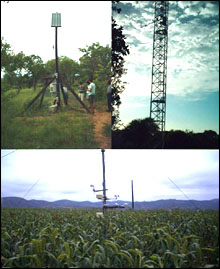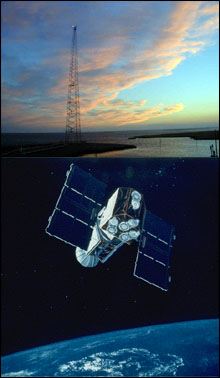The Sensor Web and SAEON
|
By Graeme McFerren of the Sensor Web initiative at Meraka
Institute, CSIR and Avinash Chuntharpursat, SAEON’s Information
Management Coordinator
In a world where numerous sensors are collecting data every second (or less) of every day, it is important to get a handle on all this data and information.
More value can be derived from integrating this data and deriving models that speak to the bigger picture. It is here that the people involved in sensor web research at the Meraka Institute of the CSIR and their international network become involved.
The sensor web concept originated at the NASA Jet Propulsion Laboratory in the late 1990s (Delin, et al. 2005; Liang, et al., 2005), originally describing a system of spatially distributed sensor platforms, communicating wirelessly amongst themselves and deployed to monitor and explore new environments.
This description, from the context of space exploration, has been broadened. Sensor web is now understood to be support infrastructure to enable groups of sensors to produce more value than would otherwise result from individual observations (Mandl, D., 2004; Liang, et al., 2005).
Emphasis is placed on the multiple modes of observation - sensors can be orbital, airborne, terrestrial or marine; they can be mobile or fixed. Flood gauges, air pollution monitors, stress gauges on bridges, Webcams and remote sensors on orbiting satellites are some examples of this heterogeneous range of sensors (Percival, et al., 2006).
Observations of many phenomena can occur at different scales - global, regional, local, and even at site-specific level (Liang, et al., 2005; Delin, et al., 2005). Sensors are able to share data and may react to each other to provide improved, more timely or more responsive observations.
Higher fidelity observations
Advances in sensor, communications and computing technologies allow for higher fidelity observations, more easily captured by smaller and cheaper devices, using less energy, with increased processing power and data storage.
Availability of greater volumes of communications bandwidth enables the increased levels of communications that characterise sensor web. The effect is the emergence of virtual macro-instruments, or a single, distributed sensing instrument (Delin, K., 2002; Delin, et al. 2005; Liang, et al., 2005; Moodley and Simonis, 2006). The accompanying pictures show examples of the typical sensors that SAEON has an interest in.
A further elaboration of the sensor web concept describes a high-level "Sensor Web", a distributed, global system of sensors, sensor networks, processed sensor observations, databases and simulations that can be dynamically configured to allow for information synthesis over a large spatial area and tracking of dynamic phenomena (Delin, K., 2002; Liang, et al., 2005).
There is a strong drive towards Sensor Web Enablement (SWE) whereby sensor assets are made interoperable and available on the Internet through standardised interfaces, data encodings and metadata. Emphasis is placed on discovery of sensor assets and description of their capabilities and quality. This would allow automated processing of sensor data and even tasking of sensors to acquire observations of interest (Botts, et al., 2006; Percival, et al., 2006).
Availability of Internet-resident sensors has significance for many domains, including environmental monitoring and assessment, public safety, disaster management, transportation monitoring and management, and infrastructure monitoring and management (Percival, et al., 2006).
It has been suggested that an increasingly pervasive sensor web will revolutionise Earth system science much like remote sensing did in the 1970s, and become a key component in environmental analysis (Hart and Martinez, 2006; Mandl, et al., 2006).
Realisation of the Sensor Web will lead to an explosion in availability, volume, coverage and utility of data (Hart and Martinez, 2006; Moodley and Simonis, 2006; NSF Cyberinfrastructure Council, 2006).
Information layer
An information layer becomes important. This is where sensor assets could be stored, disseminated, exchanged, managed, displayed and analysed in support of a variety of access demands, data uses and data users (Liang, et al., 2005).
The challenge of sense-making becomes crucial - how do we interpret the world around us based on multitudes of inputs and (possibly) multiple ways of explaining these inputs (Snowden, 2005)?
Possibilities arise for combining and integrating data to reveal new insights and create deeper, more complex understandings of phenomena (NSF Cyberinfrastructure Council, 2006). Knowledge discovery in distributed observational datasets becomes important for summarising, synthesising and uncovering patterns and relationships and for making such results available in meaningful, contextual ways (ibid.; Liang, et al., 2005; Hand, et. al. 2001; Ramachandran, et. al., 2006; Durbha and King, 2005).
Important role of sensors in SAEON data
With SAEON nodes rapidly rising and associated research and observation sites being implemented, sensors will play an increasing role in the collection of SAEON data. With advances in Information Technology and (hopefully) bandwidth it is envisaged that the sensor web will play an ever increasing role in adding value to this data.
SAEON has partnered with the sensor web initiative in areas such as metadata technologies and investigations into ontologies (read: Using ontologies to manage ecological data, April 2007).
References
Botts, M., Robin, A., Davidson, J. and Simonis, I., 2006. OpenGIS® Sensor Web Enablement Architecture Document. Open Geospatial Consortium, OGC 06-021, 2006
Delin, K., 2002 The Sensor Web: A Macro-Instrument for Coordinated Sensing. Sensors, 2, 270-285. Online Journal, http://www.mdpi.org/sensors
Delin, K., Jackson, S.P., Johnson, D.W., Burleigh, S.C., Woodrow, R.R., McAuley, J.M., Dohm, J.M., Ip, F., Ferre, T.P.A., Rucker, D.F. and Baker, V.R., 2005. Environmental Studies with the Sensor Web: Principles and Practice. Sensors, 5, 103-117. Online Journal, http://www.mdpi.org/sensors
Durbha, S.S. and King, R.L., 2005. Semantics-Enabled Framework for Knowledge Discovery From Earth Observation Data Archives. IEEE Transactions on Geoscience and Remote Sensing, Vol. 43, No. 11, November 2005
Hart, J.K. and Martinez, K., 2006. Environmental Sensor Networks: A revolution in the earth system science? Earth-Science Reviews 78 (2006) 177 – 191
Liang, S. H. L. C. and Tao, C. V. ., 2005. A Distributed Geospatial Infrastructure for the Sensor Web. Computers & Geosciences 31(2), pp. 221–231.
Mandl, D. 2004, Experimenting with Sensor Webs Using Earth Observing 1. 2004 IEEE Aerospace Conference Proceedings, 176-183
Mandl, D., Frye, S.W., Goldberg, M.D., Habib, S., Talabac, S. 2006 Sensor Webs: Where They are Today and What are the Future Needs? Panel Discussion, Proceedings of the Second IEEE Workshop on Dependability and Security in Sensor Networks and Systems (DSSNS’06)
Moodley, D. and Simonis, I., 2006. A New Architecture for the Sensor Web: The SWAP Framework. Proceedings of the Semantic Sensor Networks Workshop, in Supplemental Proceedings of the 5th International Semantic Web Conference. Athens, Georgia, 5-9 November 2006
NSF Cyberinfrastructure Council, 2006. NSF’S Cyberinfrastructure Vision For 21st Century Discovery. National Science Foundation, Arlington, Virginai, USA. From http://www.nsf.gov/od/oci/ci-v7.pdf, Accessed 10/01/2007
Percival, G. and Reed, C., 2006. OGC® Sensor Web Enablement Standards. Sensors & Transducers Journal, Vol.71, Issue 9, September 2006, pp.698-706
Ramachandran, U., Kumar, R., Wolenetz, M., Cooper, B., Agarwalla, B., Shin, J., Hutto, P. and Paul, A., 2006. Dynamic Data Fusion for Future Sensor Networks. ACM Transactions on Sensor Networks, Vol. 2, No. 3, August 2006, Pages 404–443.
Snowden, D.J., 2005. Multi-ontology sense making - a new simplicity in decision making. Management Today, Yearbook 2005, Vol 20; www.kwork.org/Stars/Snowden/Snowden.pdf. Accessed 10/01/2007












